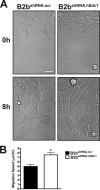Transmembrane and extracellular domains of syndecan-1 have distinct functions in regulating lung epithelial migration and adhesion
- PMID: 22936802
- PMCID: PMC3471708
- DOI: 10.1074/jbc.M112.376814
Transmembrane and extracellular domains of syndecan-1 have distinct functions in regulating lung epithelial migration and adhesion
Abstract
Syndecan-1 is a cell surface proteoglycan that can organize co-receptors into a multimeric complex to transduce intracellular signals. The syndecan-1 core protein has multiple domains that confer distinct cell- and tissue-specific functions. Indeed, the extracellular, transmembrane, and cytoplasmic domains have all been found to regulate specific cellular processes. Our previous work demonstrated that syndecan-1 controls lung epithelial migration and adhesion. Here, we identified the necessary domains of the syndecan-1 core protein that modulate its function in lung epithelial repair. We found that the syndecan-1 transmembrane domain has a regulatory function in controlling focal adhesion disassembly, which in turn controls cell migration speed. In contrast, the extracellular domain facilitates cell adhesion through affinity modulation of α(2)β(1) integrin. These findings highlight the fact that syndecan-1 is a multidimensional cell surface receptor that has several regulatory domains to control various biological processes. In particular, the lung epithelium requires the syndecan-1 transmembrane domain to govern cell migration and is independent from its ability to control cell adhesion via the extracellular domain.
Figures






Similar articles
-
MMP7 shedding of syndecan-1 facilitates re-epithelialization by affecting alpha(2)beta(1) integrin activation.PLoS One. 2009 Aug 10;4(8):e6565. doi: 10.1371/journal.pone.0006565. PLoS One. 2009. PMID: 19668337 Free PMC article.
-
Specific syndecan-1 domains regulate mesenchymal tumor cell adhesion, motility and migration.PLoS One. 2011;6(6):e14816. doi: 10.1371/journal.pone.0014816. Epub 2011 Jun 23. PLoS One. 2011. PMID: 21731601 Free PMC article.
-
Syndecan-1 controls cell migration by activating Rap1 to regulate focal adhesion disassembly.J Cell Sci. 2012 Nov 1;125(Pt 21):5188-95. doi: 10.1242/jcs.109884. Epub 2012 Aug 16. J Cell Sci. 2012. PMID: 22899717 Free PMC article.
-
Syndecan transmembrane domain modulates intracellular signaling by regulating the oligomeric status of the cytoplasmic domain.Cell Signal. 2018 Dec;52:121-126. doi: 10.1016/j.cellsig.2018.09.003. Epub 2018 Sep 6. Cell Signal. 2018. PMID: 30195038 Review.
-
Novel insight into the biological functions of syndecan ectodomain core proteins.Biofactors. 2013 Jul-Aug;39(4):374-82. doi: 10.1002/biof.1104. Epub 2013 Apr 5. Biofactors. 2013. PMID: 23559542 Review.
Cited by
-
The role of the alveolar epithelial glycocalyx in acute respiratory distress syndrome.Am J Physiol Cell Physiol. 2023 Apr 1;324(4):C799-C806. doi: 10.1152/ajpcell.00555.2022. Epub 2023 Feb 27. Am J Physiol Cell Physiol. 2023. PMID: 36847444 Free PMC article. Review.
-
Temporo-spatial cellular atlas of the regenerating alveolar niche in idiopathic pulmonary fibrosis.Nat Commun. 2025 Aug 4;16(1):7150. doi: 10.1038/s41467-025-61880-1. Nat Commun. 2025. PMID: 40759629 Free PMC article.
-
Syndecan-1 Controls Lung Tumorigenesis by Regulating miRNAs Packaged in Exosomes.Am J Pathol. 2018 Apr;188(4):1094-1103. doi: 10.1016/j.ajpath.2017.12.009. Epub 2018 Jan 31. Am J Pathol. 2018. PMID: 29355516 Free PMC article.
-
Syndecan-1 and E-Cadherin Expression in Canine Cutaneous Squamous Cell Carcinoma.Vet Sci. 2024 Dec 14;11(12):652. doi: 10.3390/vetsci11120652. Vet Sci. 2024. PMID: 39728992 Free PMC article.
-
Syndecan-1 and Its Expanding List of Contacts.Adv Wound Care (New Rochelle). 2015 Apr 1;4(4):235-249. doi: 10.1089/wound.2014.0555. Adv Wound Care (New Rochelle). 2015. PMID: 25945286 Free PMC article. Review.
References
-
- Couchman J. R. (2003) Syndecans: proteoglycan regulators of cell-surface microdomains? Nat. Rev. Mol. Cell Biol. 4, 926–937 - PubMed
-
- Couchman J. R. (2010) Transmembrane signaling proteoglycans. Annu. Rev. Cell Dev. Biol. 26, 89–114 - PubMed
-
- Beauvais D. M., Rapraeger A. C. (2003) Syndecan-1-mediated cell spreading requires signaling by αvβ3 integrins in human breast carcinoma cells. Exp. Cell Res. 286, 219–232 - PubMed
Publication types
MeSH terms
Substances
Grants and funding
LinkOut - more resources
Full Text Sources
Other Literature Sources
Molecular Biology Databases
Miscellaneous

